How and from what to germinate potatoes before planting
Germination of planting material is one of the mandatory procedures for cultivating potatoes. The event allows you to reject low-quality seeds, calibrate them by size and weight, accelerate the formation of stolons and tubers, and prevent the development of viral and fungal diseases.
The article will tell you what methods and means will help to properly germinate potatoes for planting.
Why germinate potatoes before planting?
What do potatoes sprout from? The process begins with the upper eyes. As a rule, one bud grows. Breaking off seedlings inhibits the development and growth of the plant and weakens the growth processes of tubers.
Correct and timely preparation triggers the biological processes of sprout formation and root development. After germination, the planting material is sorted - rotten, unproductive tubers with weak or without seedlings are removed. As a result, after planting, friendly, strong and healthy seedlings appear.
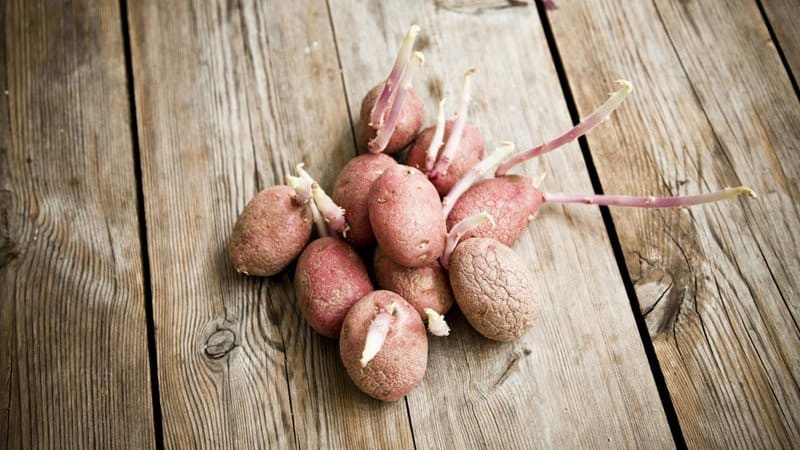
Selection of tubers and preparation of potatoes
In the fall, seed material is selected and subjected to landscaping - a procedure that increases the safety of tubers. The potatoes are left for a week in a lighted place, turning them over periodically. The tubers become hard, do not lose moisture, mice do not touch them in storage, and the wounds heal faster. They are stored at a temperature of +4°C and air humidity of 60-65%.An increase in indicators leads to the premature appearance of sprouts, and a decrease leads to freezing of the material.
20-40 days before the intended planting, the harvested potatoes are taken out of the cellar and taken out into the sunlight. Then they are re-sorted, those unsuitable for planting are discarded, calibrated and washed under running water to remove residual soil and pathogenic bacteria.
Before germinating potatoes, planting material is treated with disinfecting solutions:
- 10 g of boric acid per 10 liters of water;
- 10 g of copper sulfate, 2 g of potassium permanganate, 10 g of boric acid per 10 liters of water;
- wood ash for dusting;
- "Fitosporin-M", "Prestige" according to the instructions on the package.
Additional processing increases the plant’s immunity to fungal diseases and insect attacks.
Healthy tubers with hatched eyes are suitable for germination. Practice shows that the best results can be achieved when planting tubers weighing 100 g.
Large potatoes have a greater supply of nutritional components than small ones. After planting, the tops quickly grow until they exhaust the reserves contained in the tubers. The development of the rhizome is noticeably delayed. After the tuber gives up its reserves, the underground part will not be able to fully satisfy the needs of the green mass. The situation will return to normal once balance is restored.
Experienced farmers recommend cutting large potatoes into pieces 3-4 days before planting, leaving at least three eyes on each piece. During this period, the cut will have time to cork, blocking access to pathogenic fungi and bacteria.
Planting small tubers will not provide you with a rich harvest. You will have to put 2-3 potatoes in the holes to make the most of the space. Digging Such nests will be inconvenient due to the risk of damaging the tubers with a shovel.
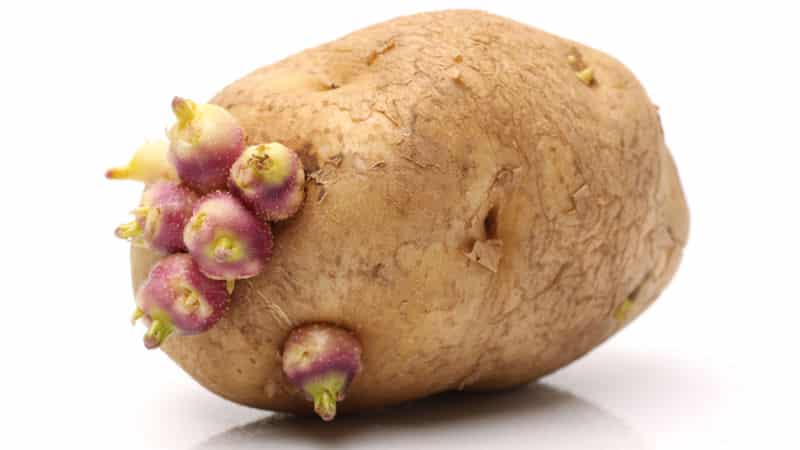
Reference. Some certified elite varieties have small planting tubers that produce a full-fledged bush of selected potatoes.
Germination methods
Many methods are used to germinate potatoes before planting, each of them is effective. The difference lies in the time and labor involved.
In the light
Germination in the light is a classic method that allows you to get the expected result.. Any room with the ability to maintain an air temperature of +12...+16°C and diffused light is suitable for this purpose.
The prepared tubers are placed in ventilated boxes, with a thin white cloth and filter paper placed on top. In such conditions, seedlings appear in 30-40 days. They “sit” firmly on the tubers and do not break off during transportation. To plant potatoes in early May, the seeds are taken out of storage in late March - early April.
Advice. If it is not possible to create the right conditions, use fluorescent lamps for illumination. The lighting time for tubers is 8-10 hours.
In the dark
Sprouting potatoes in the dark is the easiest and most commonly used method. The prepared tubers are placed in containers and left in a dark, ventilated room. Optimum air temperature +14…+16°С. The disadvantage of this method is that the seedlings grow white, long and brittle. Planting is carried out extremely carefully, trying not to break them off.
Wet germination
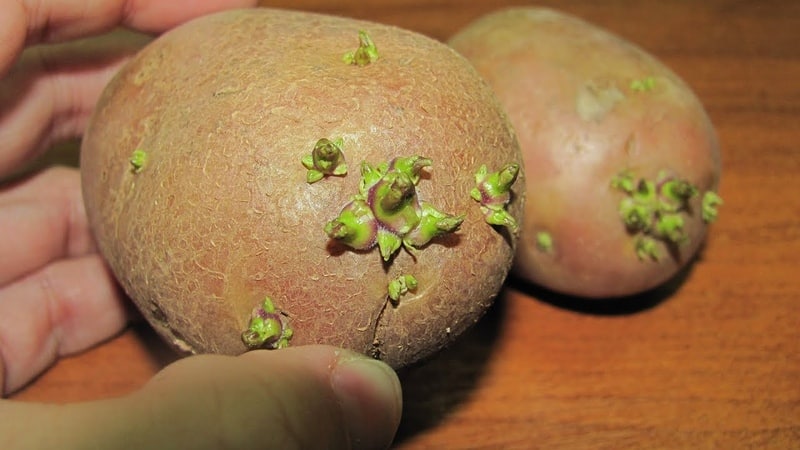
The essence of this method is to place the tubers in a humid environment, which accelerates the formation of seedlings and roots. The prepared material is placed in boxes filled with a breathable substrate: peat, humus, sawdust.
A layer of wet substrate is placed at the bottom of the box, the potatoes are laid out in one layer and covered with sawdust or peat. Form no more than four layers, otherwise air circulation will be difficult. The gap between tubers is 1-2 cm. The height of the layer of sawdust or peat is 3 cm.
The planting material is periodically moistened using a sprayer. The optimal air temperature is not lower than +12°C and not higher than +25°C. Germination time is 12-15 days.
Important! During the germination process, make sure that the sprouts do not exceed the size of the tubers, otherwise they will break off during transportation.
In polyethylene film
This method is suitable for germinating potatoes in a city apartment. Processed potatoes are placed in a thick plastic bag - 12 pcs. in each. Holes are made in the bags for air circulation and hung on hooks near the window. The bags are rotated regularly so that the tubers are illuminated from all sides. Sprouts appear after 3 weeks.
In pots
This method is not particularly popular among gardeners due to the labor-intensive process. 30 days before planting, the seed material is placed in wet sawdust, and 7-10 days later - in clay pots filled with a mixture of light substrate and humus.
The containers are placed near the window. The optimal room temperature is +12…+14°C. After the seedlings appear, the pots are taken outside during the day for hardening, and put away indoors at night. The seedlings grow strong and produce a large harvest.
In boxes with fertilizers
This method is identical to germinating potatoes in the light, with the difference that nutritional supplements are added to the container. Prepared tubers are placed in boxes with holes, the bottom is lined with peat mixed with humus. Place 2-3 cm of nutrient mixture on top of the tubers.This is how 6-8 layers are formed.
Next, the box is spilled with water using a watering can and placed in a room with a temperature of +15…+17°C. After the sprouts appear, the tubers are watered with a mineral solution - 10 g of potassium chloride, 10 g of ammonium nitrate, 10 g of superphosphate, 2 g of boron and copper per 10 liters of water, sprinkled with wood ash - 200 g per 10 liters of water. After 2-3 days, the boxes are re-watered with clean water.
After 7 days of such feeding, roots form on the tubers, which indicate the readiness of the material for planting.
On open air
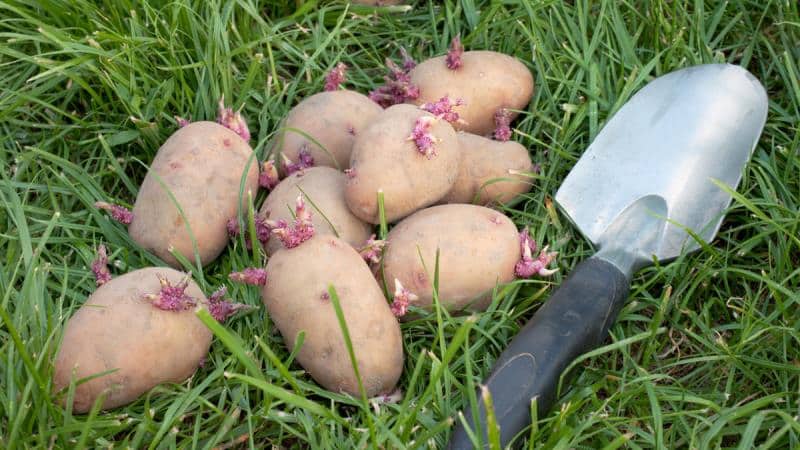
For germination, choose a flat area in the yard and lay out straw or dry peat. The tubers are laid out in rows 1.5 m wide, in 2-3 layers, with a layer of soil on top. A gap of 1 m is left between the rows. At night, the potatoes are covered with film to protect them from frost. Seedlings and roots appear within a month.
Drying and heating
These methods are used if it was not possible to get the tubers out of storage in time. For drying, the tubers are laid out in one layer in a dry room at an air temperature of +18...+25°C, and left for 10-14 days. During this time, enzymes and nutritional components accumulate in the tubers, promoting the pecking of the eyes. Such potatoes will sprout vigorously after planting.
Warming up the seed material in order to awaken the tubers is carried out 3-4 days before planting. The temperature is increased gradually, starting from +10°C for 3-4 days, and up to +25°C.
Combined method
This technique allows you to get early potatoes. The preparation of tubers for germination begins 35-40 days before planting. First, they are germinated in the light until strong, thick shoots appear. Then they are placed in boxes with a humid environment. The first layer of tubers is placed in a damp layer of substrate 5 cm thick.The soil is spilled with a nutrient solution: 60 g of superphosphate, 30 g of potassium chloride per 10 liters of water.
The boxes are kept indoors at a temperature of +20…+22°C. In such conditions, potatoes germinate in 2-3 days. To prevent root overgrowth, the temperature is reduced to +12…+14°C.
How to quickly germinate potatoes
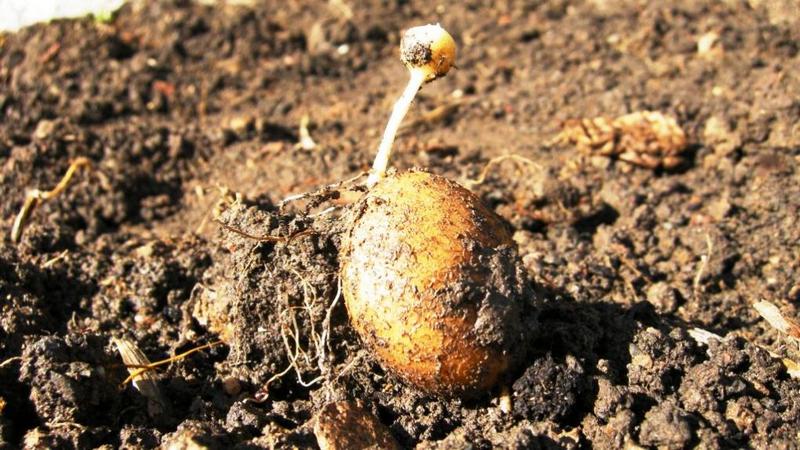
Express methods are used to quickly germinate potatoes before planting - stimulating cuts, soaking in nutrient solutions, growth stimulants.
Stimulating incisions
How to stimulate the germination of potato tubers? Applying stimulating ring cuts 1 cm deep accelerates the formation of stems and stolons. The manipulation is carried out with a sharp knife, wetting it each time in a solution of potassium permanganate. The cuts are made diagonally, without touching the eyes.
A transverse cut is made perpendicular to the axis so that only 1 cm of the tuber remains uncut. This ensures an even distribution of nutrients between the eyes. As a result, bushes with a large number of stems are formed. The yield increase is 17%.
The prepared tubers are rolled in wood ash, placed in boxes, sprinkled with sawdust and left in a dry, cool cellar.
Using Nutrient Solutions
Seed potatoes are treated with nutrient solutions 48 hours before germination. This accelerates germination and tuberization, increases yield by 10–13%.
Recipes for solutions:
- 40 g of superphosphate, 40 g of potassium salt per 10 liters of water;
- 1 kg of wood ash, 2 g of copper, 2 g of bromine per 10 liters of water;
- 30 g of potassium sulfate, 15 g of boric acid, 40 g of urea, 1 g of copper sulfate, 0.5 g of potassium permanganate;
- 40 g of urea, 60 g of superphosphate, 10 g of boric acid, 5 g of copper sulfate, 1 g of potassium permanganate per 10 liters of hot water.
Processing sprouted potatoes before planting
1-2 days before planting, sprouted tubers are treated with growth stimulants, which activate the plant’s defenses, accelerate the formation of seedlings, and increase the plant’s immunity. For this purpose, the following drugs are used: Poteytin, Mikon, Epin, Bioglobin, GUM, Planriz, Potassium Humate, Fitosporin.
To protect potatoes from insects -pests tubers are sprayed with chemicals: "Matador", "Prestige", "Maxim", "Quadris". As an alternative, folk remedies are used: wood ash, Bordeaux mixture, potassium permanganate, copper sulfate.
Tips and tricks
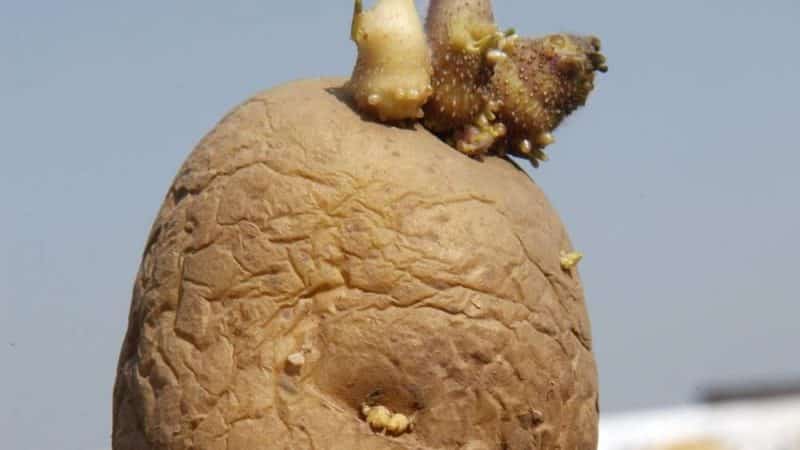
Advice from gardeners on how to properly sprout potatoes:
- Before placing the tubers in the sprouting boxes, rinse them thoroughly under the tap to remove any remaining soil and bacteria that cause rotting.
- Leave containers with seed potatoes in a ventilated area with humidity up to 85%. At low humidity, tubers quickly wither and sprouts develop at an accelerated pace. To prevent moisture loss, spray the potatoes with a spray bottle.
- To germinate in the light, lay out the potatoes in 1-2 layers.
- To obtain early new potatoes, use a comprehensive method that involves greening and germination in a humid environment.
- Do not forget to disinfect tubers before germination. This will protect the plantings from fungal infections and insect attacks.
- The appearance of green roots on the tubers is the main sign that it is time to plant.
- This method will help speed up the appearance of roots that sprout on potato tubers - immediately after the seedlings form, place the tubers in the dark for 3-4 days.
- When transporting sprouted tubers, try not to break off the sprouts.
- If the seedlings have grown large, carefully break them out without damaging the eyes and use them to obtain potato seedlings.
Read also:
Conclusion
The quality and quantity of the harvest depend on the correct preparation of planting material and the vernalization procedure, including greening of tubers, treatment with disinfecting solutions, germination and soaking in growth stimulants. The timing of the appearance of seedlings depends on the chosen method, air temperature and humidity in the room, and on average is 30 days.
Each of the methods - germination in the light, in the dark, in bags, in a humid environment, in pots, in boxes with fertilizers - gives a positive result. To increase the plant's defenses and shorten the period of sprouting, tubers are soaked in nutrient solutions and growth stimulants.